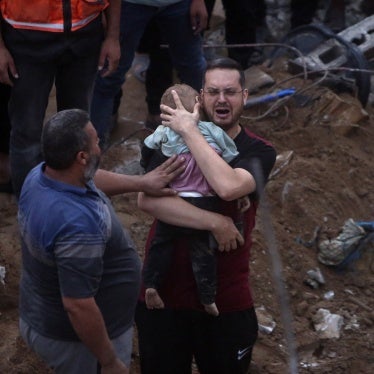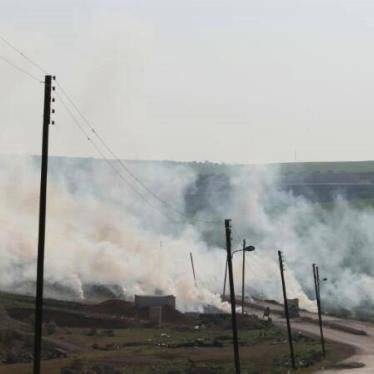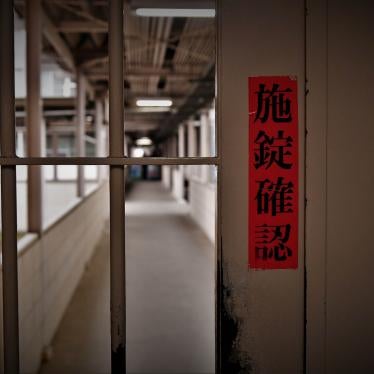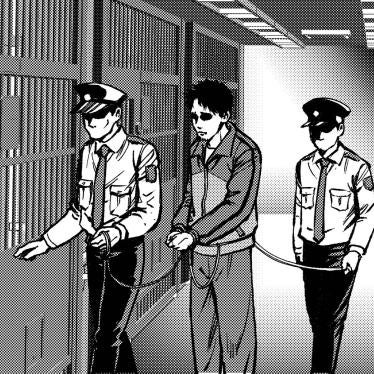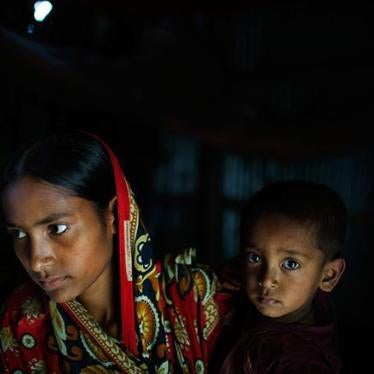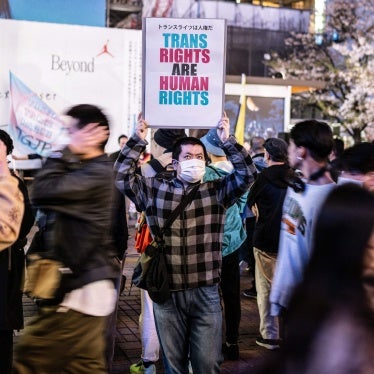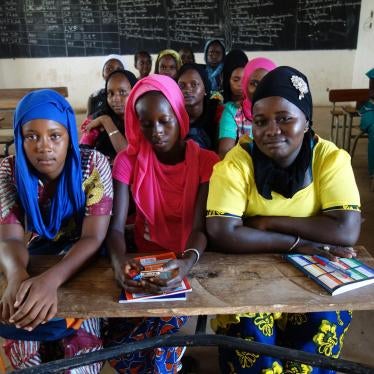(ニューヨーク)新たな衛星画像や動画、目撃証言により、シリア政府が2013年11月からアレッポの反政府勢力支配地域に行っている大規模空爆の無差別性が明らかになったと、ヒューマン・ライツ・ウォッチは本日述べた。アレッポの人口稠密地域と田園地帯への攻撃は、2014年2月22日の国連安全保障理事会決議を無視するかたちで継続されている。この決議は全当事者に対し「人口稠密地域に対し、砲撃や空爆(例えばたる爆弾(ドラム缶爆弾)の使用)などの無差別な武器使用」の停止を要求している。
アレッポと周辺田園地帯への空爆により、多数の民間人が死傷した。また大勢の人びとが家を失って避難している。現地組織の推計によれば、2013年11月1日~2014年3月21日のアレッポ州での民間人の死者は2,321人だ。
「新たな衛星画像と目撃証言から、アレッポ各地での残虐行為が明らかになった」と、ヒューマン・ライツ・ウォッチのサラ・リー・ウィットソン中東局長は述べた。「民間人居住区でのたる爆弾の使用による被害は予測された通りだ。民間人数百人が死亡し、数千人が住む家を失っている。こうした無誘導型兵器の無差別使用が軍事目標に当たったとしても、単なる偶然に過ぎない。」
ヒューマン・ライツ・ウォッチは衛星画像を解析し、アレッポ市街地の反政府勢力支配地域のうち、2013年11月から2014年2月(最新の衛星画像の解析時点)までに被害を受けた地点を少なくとも340カ所特定した。特定された地点の多くで、たる爆弾の爆発との一致度が高い損傷の痕跡があった。これは強力な爆発力を持つ無誘導型の爆弾で、現地で安価に製造されている。大型のドラム缶やガス・シリンダー、水槽に、破裂を促すための爆薬や鉄くずを詰め込んで作られており、ヘリコプターから投下される。
被害地点は反政府組織の支配地域ほぼ全体に広がっている。半数以上が前線から遠く離れ、建物が密集した民間人居住区に落下している。ヒューマン・ライツ・ウォッチが目撃証言を聞いた事例のほとんどで、目撃者は近くに軍事目標がないと述べていた。このことは一連の攻撃の無差別的性格を示すものだ。
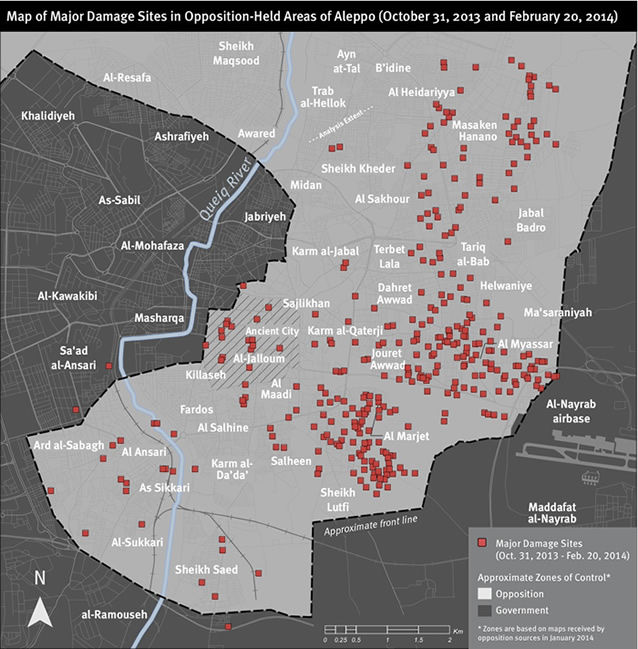
Caption: Map of the 340 major damage sites identified between November 1 and February 20, 2014.
3月中旬以降、安全保障理事会がたる爆弾の使用停止を求めた後にトルコに到着した難民や、シリア国内で避難民となった人びとはヒューマン・ライツ・ウォッチの調査員に対し、アレッポの住宅・商業地域に対してほぼ連日無差別空爆が行われていたと述べた。またそのほとんどがたる爆弾によるもので、近くに軍事目標は確認できなかったと言う。住民は口を揃えて、ヘリコプターがたる爆弾を頭上から投下したのを目撃したときの様子や、投下時の典型的な音を聞いたこと、不発弾や明らかにたる爆弾の残骸とわかる物体を目撃したことなどを述べた。
アレッポ北西のラヴタン(Hravtan)での12月19日のたる爆弾攻撃では、ヌラ・アル=アブドゥさん(13)の頭部が切断され、9歳の少女1人が重傷を負った。この少女はヒューマン・ライツ・ウォッチに対し、爆弾投下時には自宅の階段を降りているところだったと述べた。この攻撃で本人は足の膝上部分を失った。また親戚も亡くなっている。「ヘリコプターの音を聞きましたが、[避難する]時間がなかった」と、この少女は述べた。「たる爆弾が落ちてきて、ヌラが死に、私も足を失った。」
たる爆弾など無誘導型爆弾が密集した居住地域に繰り返し用いられていることは、爆撃が単発的な出来事ではなく、こうした地域への攻撃を意図した戦略の一環であることを示唆している。たとえば衛星画像は、アレッポ市街の住宅地マサケン・ハナノ(Masaken Hanano)とジュレト・アワド(Jouret Awad)に空爆被害を受けたと思われる地点が30以上あり、100棟以上の建物が破壊されたことを示している。ヒューマン・ライツ・ウォッチはジュレト・アワドでの目撃証言を得ることができなかった。しかしマサケン・ハナノの目撃者2人はヒューマン・ライツ・ウォッチに対し、一帯には反政府武装勢力の兵舎があったが、兵舎などの軍事目標はたる爆弾の落下地点から離れていたと述べた。
シリアを拠点とする監視団体、人権侵害証拠収集センター(Violations Documentation Center)によれば、アレッポと周辺の田園地帯では2013年11月1日から2014年1月31日までに266回以上の空爆があり、少なくとも1,380人が死亡した。うち441人が子ども、78人が女性、14人が戦闘員だった。医者や病院への聞き取りに基づき、同センターは空爆の負傷者を2万人以上と推計している。同センターは、この地域での11月1日から3月21日の空爆による死者として2,321人を記録している。現地で活動するシリア人権ネットワーク(SNHR)は、アレッポ市街地と周辺の田園地帯に対する政府軍の空爆で、2013年11月23日から2014年2月24日までに2,426人が死亡したと報告した。
空爆によりアレッポの反政府組織の支配地域から、民間人が大量に避難している。トルコ国境の街キリスで、都市部からの難民の登録作業を行っているシリア人の援助コーディネーターは3月中旬、ヒューマン・ライツ・ウォッチに対し、政府軍の空爆が増えた2013年11月以降でアレッポから避難した約5,000~6,000世帯がキリスで難民となっていると述べた。
2月22日に全会一致で採択された国連安全保障理事会決議は、全当事者に「民間人攻撃の即時全面停止」を求めており、とくに「人口稠密地域に対し、砲撃や空爆(例えばたる爆弾の使用)などの無差別な武器使用」の停止を要求している。安保理はまた「この決議に従わない場合について追加措置を取る意志」を明確に表明している。
軍司令官は、そもそも方針として、民間人の被害が予測される以上、人口稠密地域に対しては広範囲な被害をもたらす爆発型兵器の使用を命令すべきではないと、ヒューマン・ライツ・ウォッチは述べた。シリア政府軍はたる爆弾を人口稠密地域に使用し、戦争を行う手段と方法として、民間人と戦闘員の区別が不可能なものを用いている。こうした攻撃は無差別的なものとなり、したがって違法である。
シリアが民間人居住区に無差別空爆を続けていることを踏まえ、安全保障理事会はシリア政府、ならびに広範な、または組織的な人権侵害に関与するあらゆる組織に対して武器禁輸措置を課すとともに、シリアの事態を国際刑事裁判所(ICC)に付託すべきであると、ヒューマン・ライツ・ウォッチは述べた。武器禁輸措置が実施されれば、シリア政府の空爆遂行能力は制限される。たとえば、シリア政府がヘリコプターについて、新品や現在海外で使われているものを調達することもできなくなる。
さらに、シリア軍と治安部隊が進行中の戦争犯罪と人道に対する罪に責任があるとの説得的な証拠に照らせば、シリア政府、ならびに人道に対する罪や戦争犯罪に荷担している反政府武装勢力に武器や弾薬、物資を供給し続けている企業や個人もまた、これらの犯罪への共謀に問われる可能性があると、ヒューマン・ライツ・ウォッチは警告した。
国際法によれば、人道に対する罪の遂行に用いられる可能性のある武器をシリア軍や武装組織に提供することは、これらの犯罪の遂行の支援に該当する可能性がある。武器提供者は、これらの犯罪の共犯として刑事罰に問われる可能性があり、訴追されることもあると、ヒューマン・ライツ・ウォッチは述べた。
「この3年間、シリアは政権にほとんどダメージを受けないまま民間人攻撃を続けている」と、前出のウィットソン局長は述べた。「国連安全保障理事会は、安保理決議がこのように無視されていることに対応すべきである。武器禁輸措置を実施し、広範な人権侵害への処罰の可能性を示すべきだ。」
Satellite Imagery and Video Analysis
Human Rights Watch identified at least 340 distinct damage sites in Aleppo city’s opposition-held neighborhood damaged between early November and February 20, 2014, by analyzing four satellite images recorded over the city between October 31, 2013, and February 20, 2014. The heaviest concentration of the 340 distinct damage sites identified in Aleppo city were in the neighborhoods of al-Marjet, Jouret Awwad, al-Myassar, Helwaniye/Tariq al-Bab, Salheen, al-Sakhour, al-Heidariyya, Dahret Awwad, and Masaken Hanano.
Both the level and the location of this destruction varied from the damage Aleppo had seen prior to this government offensive. Approximately 300 major damage sites were identified from earlier dates of satellite imagery recorded between mid-2012 to October 31, 2013, a number now exceededin less than four months. And the pattern of these sites shifted, with earlier sites more concentrated in certain neighborhoods and closer to disputed areas, and the newer sites revealing wide scale destruction of neighborhoods that had been relatively undamaged and were further from active conflict.
Although some of the damage sites identified in the satellite imagery were likely caused by the effects of other explosive weapons, such as prolonged artillery shelling and a handful of apparent attacks by guided munitions, a substantial majority of these 340 sites have damage signatures strongly consistent with the detonation of high explosive unguided bombs.
Barrel bombs, and other high explosive unguided bombs, tend to create larger zones of building destruction than is typically seen with other types of air strikes and artillery fire, often with irregularly shaped blast craters of shallow depth with “scalloped edges.”
Caption: Typical signature of barrel bomb impact site
Human Rights Watch has further determined from a review of YouTube videos, satellite imagery and testimony that a small number of damage sites identified near front line positions since the beginning of the government offensive are likely attributable to opposition forces. In one documented case opposition forces dug tunnels under government-held positions near the citadel and detonated two large explosive charges destroying multiple buildings and possibly damaging the ancient citadel between February 2 and 20, 2014.
Barrel bombs account for much, if not most, of the damage that Syria’s aerial campaign has inflicted on Aleppo’s residential neighborhoods, Human Rights Watch has concluded, based on its examination of satellite imagery, video footage, and witness testimony.
Human Rights Watch reviewed over 70 videos posted to YouTube during this period, to verify the use of barrel bombs by government forces, assess the scale of damages and establish the presence of civilians at the time of the attacks. When possible, the video recording locations and impact sites as seen in videos were determined by matching common landmarks with satellite imagery.
Many videos reviewed clearly show government helicopters releasing one or more barrel bombs over residential areas in Aleppo, as distinguished by their large shape and usually unstable motion while in free fall. Barrel bombs also are distinguished because they are often pushed out or dropped from the back ramp of the helicopter. Human Rights Watch also reviewed videos of the unexploded barrel bombs on the ground.
In one case, a video posted to YouTube on February 2, shows a government Mi-8/Mi-17 “Hip” multipurpose helicopter dropping three barrel bombs on the neighborhood of Tariq al-Bab during a 10-minute period. Human Rights Watch identified both the exact video recording position as well as the location of the first barrel bomb impact site shown in the video by matching it with common landmarks in satellite imagery. A second video of the aftermath of the first attack posted to YouTube on the same day shows the destruction of at least three buildings, as well as a large civilian presence at the time of the attack. Human Rights Watch determined the incident occurred between January 31 and February 2 based on satellite imagery.
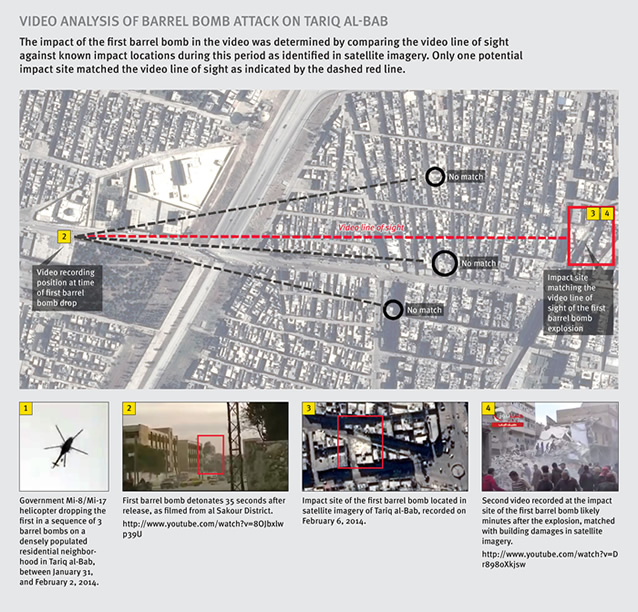
Caption: Video of Government Mi-8/Mi-17 helicopter dropping barrel bombs on residential areas matched to satellite imagery.
Download PDF (11MB) for high-resolution >>
Witness Accounts
Human Rights Watch also interviewed 30 Aleppo residents, most of them after they escaped the city, about air strikes between December 2013 and March 2014, and corroborated their statements wherever possible by analyzing video and photographs posted on the Internet. All those interviewed described helicopters hovering high over their neighborhoods and dropping barrel bombs.
In all but one case of barrel bomb attacks that residents described to Human Rights Watch, witnesses said there were no military targets nearby at the time of the attack. One witness from Masaken Hanano told Human Rights Watch that fighters from armed opposition groups were sleeping in residential buildings in the neighborhood at the time of the attack, but that they were not near the strike site and were not hit.
Attacks since the UN Resolution
Hraytan
According to witnesses who spoke to Human Rights Watch, on February 23 a barrel bomb hit a family compound approximately 100 meters from Hraytan public square killing three civilians, including a child, and injuring two more. Human Rights Watch spoke with several members of the Masri family, whose house was hit, who explained that Hassan Mahmoud Masri, approximately 70 years old, was killed in the attack along with his five-year-old grandson, and neighbor Fouad Ali Belkesh. The Violations Documentation Center identifies Hassan Masri, Ghaith Masri, a child, and Belkeshas having been killed by barrel bomb strikes on Hraytan on February 23.
According to the relatives, the attack also injured Masri’s two adult daughters, one of whom lost her right arm. Human Rights Watch reviewed a video taken of the aftermath of the attack shortly after it took place with a family member who identified the victims. This relative also explained that there were no military positions near the home or the town square, which he described as an active commercial area.
Anzarat Neighborhood
In the last days of February two barrel bombs struck a residential building in the Anzarat neighborhood at approximately 11:00 a.m., witnesses said. “Wajih,” (names in quotes have been changed to protect the identifies of the witnesses) one of the residents of the building, originally from Azaz, which he had fled to escape government shelling, told Human Rights Watch that the attack took place while he, his wife and five children, the youngest just 20 days old, were home. He said that his wife, father, and brother were all injured in the attack, along with another woman who lost her arm and eye. He said that he also saw two people killed in the attack, a man who lived in his building and a 45-year-old woman.
“The barrel destroyed our building,” he said. “My youngest was nearly dead for 30 minutes but they revived him. My wife was injured on her mouth, right hand, and waist from shrapnel. The barrel fell just 15 meters in front of the house and the house collapsed …We left the same day, and so did most other people.”
He told Human Rights Watch that the nearest front line was four kilometers away, and that their home was in a residential area with schools and mosques in it, but no military sites, checkpoints, or fighters.
The HaidariyehRoundabout
The Syrian Air Force has repeatedly hit the Haidariyeh roundabout, a key intersection on one of the main roads connecting opposition-controlled Aleppo to the countryside. The roundabout is also a gathering point for buses serving the Aleppo countryside, so it is usually crowded with civilians, residents told Human Rights Watch. Human Rights Watch has previously reported on attacks in Haidariyeh including on December 15 and 16. Three witnesses also told Human Rights Watch that the roundabout was attacked more recently.
Two residents told Human Rights Watch on March 17 that the roundabout was attacked about 20 days beforehand. One resident, “Samer,” said that three barrel bombs struck the roundabout one right after the other, killing civilians who were in taxis and microbuses there. A second witness, “Nidal,” speaking about the same attack, said that while he was leaving Aleppo for the countryside, barrels struck the roundabout, hitting microbuses that were parked there. “A Suzuki full of displaced people was hit in the Haidariyeh roundabout and other microbuses were also hit with a barrel bomb. Thirteen people from the same family died,” he said.
Wajih also told Human Rights Watch that on March 13 while he was on his way back to Aleppo, the roundabout was again struck by two barrel bombs on the Haidariyeh bus gathering point, where cars and microbuses were parked. He could not estimate the number of dead, but said that large numbers of residents in cars that were hit were killed.
Anadan
In an aerial attack on the evening of March 12 two bombs fell on east Anadan, a town northwest of Aleppo, killing members of the al-Ateek family. A witness from Anadan who saw first responders taking the injured to hospitals and collecting corpses, told Human Rights Watch that Ahmed al-Ateek’s family of five was killed in the aerial attack by barrel bombs that fell on their home and that approximately 30 other people were injured in the strikes. He described the area as residential and told Human Rights Watch that armed groups are not present in the vicinity. The Violations Documentation Center identifiedfour members of the al-Ateek family who were killed on March 12 in Anadan in an airstrike: Hassan al-Ateek, Zalegat al-Ateek, and two children, Khadija Mohammed al-Ateek and Imad Mohammed al-Ateek.
Earlier Barrel Bomb Attacks
Hraytan
On December 19, a Syrian government helicopter dropped at least two bombs that witnesses described as barrel bombs in the town of Hraytan, to the northwest of Aleppo city. The second of these bombs decapitated Noura al-Abdu, aged 13, and injured a second girl, “Wafa”, aged nine. “I was in the market when the attack happened,” Wafa’s mother told Human Rights Watch. “I heard about it just 10 minutes afterwards. People were talking, and saying that a barrel had just fallen in our street … by the time I got home they had already taken her [to the hospital].”
Wafa explained that she was going down the stairs in her building when the bomb fell, severing her leg above the knee, and killing her relative. “We heard the helicopter but I couldn’t make it down in time [to hide],” she said. “The barrel came and killed Noura and took my legs.”
Wafa’s mother explained that one leg was severed in the initial attack, but that the other, which was also injured, was later amputated at a hospital in Turkey. She told Human Rights Watch that they knew a barrel bomb caused the injuries because a relative saw the bomb falling towards them from a helicopter.
She said that there were no armed opposition military positions in their town but that there was an opposition-run police station there, although this was one kilometer away. While this was the first barrel bomb to hit their neighborhood, Wafa’s mother explained that it is not the first time their neighborhood has been bombed, despite it being a residential area.
Human Rights Watch also reviewed five videos taken shortly after the attack. In oneof these videos a girl seen being carried by a man was identified by the videographer as Noura.
Tariq al-Bab
In a December 28 attack, a civilian witness who saw a helicopter overhead and then the destruction caused by its bombing, told Human Rights Watch that barrel bombs struck the western part of the vegetable market in the Tariq al-Bab neighborhood between midday and 3 p.m. “They bomb areas like this where people gathering so that they will leave,” he said. “There are no [armed opposition] military positions there.”
He estimated that the closest military target was about five kilometers away. The witness believed that dozens of market-goers were killed in the attack. The Syrian Network for Human Rights has identified36 individuals, including seven children, who were killed by barrel bombs in the Tariq al-Bab vegetable market on December 28. The Violations Documentation Center has identified 20 victims, including four children.
Masaken Hanano Neighborhood
Human Rights Watch has identified a total of 35 distinct impact sites in the Masaken Hanano neighborhood in north-eastern Aleppo between early November 2013 and February 20, 2014. A majority of the attacks occurred between February 6 and 20. Most of the sites have damage signatures strongly consistent with the use of barrel bombs and possibly conventional bombs dropped by helicopters. Impact sites are almost exclusively located in neighborhoods with a high density of residential buildings. In addition to the 35 main damage sites, multiple impact craters from artillery shelling were also identified, indicating that both government ground and air forces have targeted the district.

Caption: The map illustrates 17 probable air strike / barrel bomb impact sites (highlighted in red) concentrated in the middle of a large residential area on the eastern side of Masaken Hanano. All but one attack in this section occurred in February 2014.
Human Rights Watch spoke to two witnesses from Masaken Hanano who described two separate barrel bomb attacks on the neighborhood in February in which civilians were killed or injured.
“Bassel,” a media activist from Masaken Hanano, told Human Rights Watch that on February 6, he documented a barrel bomb attack in the eastern section of the neighborhood. Before the attack he saw a helicopter hovering over the neighborhood and then received a call from a friend who told him the helicopter had dropped a barrel bomb there. He said that on arriving at the scene approximately 20 minutes after the barrel bomb struck, he saw 14 civilians who were killed, including four women and two children, two buildings destroyed and several others damaged, and six to seven destroyed cars. Bassel identified 11 of the victims by name: Abdul Kader Tabakh, Mohammed Rihawe, Abd al-Mohsen al-Hamawi, Mohamed Mahmoud Tedabli (16), Ahmad Ramadan al-Sharif, Bushra Abdulkader Tabakh, Shahla Abdulkader Tabakh, Hiba Abdulkader Tabakh, `Ala’ Tabakh, Ameen Abdulkader Tabakh (6), and Sama al-Hassan (6).
“One man was holding a dead child who looked around five years old to me,” he told Human Rights Watch. Others were injured. “The injuries that I saw were mainly severed legs and hands, and injuries caused by shrapnel,” he said. “I don’t remember the number of injured but I saw at least 20.” He told Human Rights Watch a second barrel was dropped on the northern section of the neighborhood on the same day, killing civilians, but that he did not document it. Bassel said that there was no armed opposition group presence at the time, whether fighters, checkpoints, or a military base, and that the frontline was 10 kilometers away.
“Mansour,” a media activist from the neighborhood, told Human Rights Watch that on February 10 at around 8:30 a.m. a helicopter dropped four barrel bombs in the southern part of the neighborhood near the cemetery in al-Ahmadiya. He said that he was meters from where one of the bombs dropped on a residential street and that he saw one man and woman on the street injured by that bomb. Mansour told Human Rights Watch that while there was an opposition barracks in Masaken Hanano, the frontline was five kilometers away near the Syrian government’s 80th Brigade base.
Nayrib Neighborhood
In mid-February at around 5:30 p.m. a bomb that witnesses described as a barrel bomb struck a one-story home in the Nayrib neighborhood of Aleppo city, killing a mother and her three children and injuring a fourth child. The witnesses interviewed by Human Rights Watch were unable to recall the exact date. The children’s father told Human Rights Watch that his wife, Diyah Wawee, and Hasan, 18 months, Abdelkarim, 3, and Ahmed, 10, were killed in the attack and that their fourth son was injured. He also told Human Rights Watch that the same bomb killed his brother’s son, Mohammed, 10, and daughter, Fatima, 2, and a third child, Mohammed al-Ali Wawee. He said that the bomb hit their homes in a residential area where no military targets were present.
Hendarat Palestinian camp in Aleppo
Human Rights Watch spoke to four men from the Hendarat Palestinian refugee camp, northeast of Aleppo city, who said they had fled the area with their families because of the government’s barrel bomb attacks on the camp.
According to the men, surrounding neighborhoods were hit with barrel bombs in the days before the camp itself was struck on February 21, after which more than 200 camp residents from 48 families decided to flee to Turkey. One man, “Omar,” told Human Rights Watch that this was the third mass displacement from the camp because of the war, and that almost none of the original 7,000-8,000 inhabitants remained.
A second resident, “Bassam,” told Human Rights Watch that three barrel bombs struck part of the camp on February 21 (the Mashrou` section), at around 11:20 a.m., before Friday prayer. He said that one of these strikes killed a girl and her mother as they were walking near the water tank in the neighborhood.
Omar and two other residents also spoke to Human Rights Watch about the attack on February 21. None of the residents knew the names of the women and girl victims, and believed they were Syrians who had moved in to escape government attacks in other parts of Aleppo governorate.
The residents also told Human Rights Watch that there were no military positions inside of the camp, characterizing it as a residential area far from the frontlines. The camp, they told Human Rights Watch, is administered by a local opposition Sharia council, which the residents described as civilian. The Sharia council was not in the Mashrou` area of the camp that was hit.
